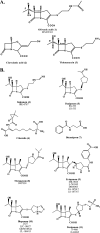Carbapenems: past, present, and future
- PMID: 21859938
- PMCID: PMC3195018
- DOI: 10.1128/AAC.00296-11
Carbapenems: past, present, and future
Abstract
In this review, we summarize the current "state of the art" of carbapenem antibiotics and their role in our antimicrobial armamentarium. Among the β-lactams currently available, carbapenems are unique because they are relatively resistant to hydrolysis by most β-lactamases, in some cases act as "slow substrates" or inhibitors of β-lactamases, and still target penicillin binding proteins. This "value-added feature" of inhibiting β-lactamases serves as a major rationale for expansion of this class of β-lactams. We describe the initial discovery and development of the carbapenem family of β-lactams. Of the early carbapenems evaluated, thienamycin demonstrated the greatest antimicrobial activity and became the parent compound for all subsequent carbapenems. To date, more than 80 compounds with mostly improved antimicrobial properties, compared to those of thienamycin, are described in the literature. We also highlight important features of the carbapenems that are presently in clinical use: imipenem-cilastatin, meropenem, ertapenem, doripenem, panipenem-betamipron, and biapenem. In closing, we emphasize some major challenges and urge the medicinal chemist to continue development of these versatile and potent compounds, as they have served us well for more than 3 decades.
Figures









References
-
- Abbanat D., Morrow B., Bush K. 2008. New agents in development for the treatment of bacterial infections. Curr. Opin. Pharmacol. 8:582–592 - PubMed
-
- Akama H., et al. 2004. Crystal structure of the membrane fusion protein, MexA, of the multidrug transporter in Pseudomonas aeruginosa. J. Biol. Chem. 279:25939–25942 - PubMed
-
- Albers-Schonberg G., et al. 1976. Abstr. 16th Intersci. Conf. Antimicrob. Agents Chemother., abstr. 229. American Society for Microbiology, Washington, DC
Publication types
MeSH terms
Substances
Grants and funding
LinkOut - more resources
Full Text Sources
Other Literature Sources
Medical
Miscellaneous

